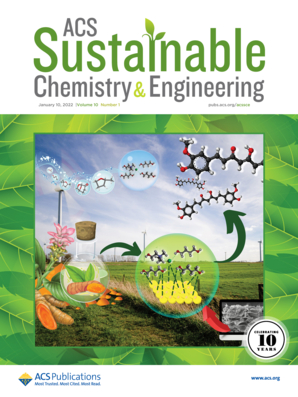Highly Selective Separation of Thorium Using an Extraction Resin by Encapsulating an Amine-Based Ionic Liquid In Situ within a Porous Silica–Polymer Matrix Instead of Conventional Impregnation Method
IF 7.3
1区 化学
Q1 CHEMISTRY, MULTIDISCIPLINARY
引用次数: 0
Abstract
The separation of thorium from uranium and rare earths is of great significance for a thorium molten salt reactor nuclear energy system. Herein, a novel Aliquat 336@SiO2–P extraction resin, prepared by the in situ encapsulation of an amine-based ionic liquid (Aliquat 336) into a porous silica–polymer matrix at the same time as the polymerization, was developed for the highly selective separation of Th(IV) over U(VI) and rare earth ions. Batch adsorption studies showed that the prepared Aliquat 336@SiO2–P extraction resin has excellent selectivity, strong adsorption affinity, and high adsorption capacity for Th(IV). The adsorption process of Th(IV) follows pseudo-second-order kinetics and the Langmuir model, and the adsorption of Th(IV) is a monolayer-type, chemical, exothermic, and spontaneous process with increased entropy, achieving a maximum Th(IV) adsorption capacity (qmax) of 52.4 mg/g. Thorium is adsorbed as a complex anion in an HNO3 solution, and its adsorption conforms to the anion exchange mechanism. Furthermore, column experiments indicated that Th(IV) can be selectively separated from simulated monazite HNO3 leach liquor with a recovery rate as high as 97.7%, and the prepared extraction resin has good reusability. Compared to the conventional impregnation method, the Aliquat 336 extractant encapsulated in a porous silica–polymer matrix has significantly lower loss during the adsorption process. Overall, this new extraction resin demonstrates great application potential for the highly efficient separation and recovery of Th(IV) from monazite HNO3 leach liquor.

通过在多孔硅聚合物基质中原位封装胺基离子液体而非传统浸渍法,利用萃取树脂实现钍的高选择性分离
钍与铀、稀土的分离对钍熔盐堆核能系统具有重要意义。本文研究了一种新型Aliquat 336@SiO2 -P萃取树脂,该树脂是在聚合的同时将胺基离子液体(Aliquat 336)原位包封到多孔硅聚合物基体中制备的,用于Th(IV) / U(VI)和稀土离子的高选择性分离。批量吸附研究表明,制备的Aliquat 336@SiO2 -P萃取树脂对Th(IV)的选择性好,吸附亲和力强,吸附量高。Th(IV)的吸附过程符合拟二级动力学和Langmuir模型,吸附过程为单层、化学、放热、熵增大的自发过程,最大Th(IV)吸附容量(qmax)为52.4 mg/g。钍在HNO3溶液中以络合阴离子吸附,其吸附符合阴离子交换机理。柱实验表明,从模拟monazite HNO3浸出液中可以选择性地分离出Th(IV),回收率高达97.7%,制备的萃取树脂具有良好的重复使用性。与传统浸渍法相比,将Aliquat 336萃取剂包封在多孔硅聚合物基体中,吸附过程中的损失明显降低。综上所述,该新型萃取树脂在单氮石HNO3浸出液中Th(IV)的高效分离和回收方面具有很大的应用潜力。
本文章由计算机程序翻译,如有差异,请以英文原文为准。
求助全文
约1分钟内获得全文
求助全文
来源期刊

ACS Sustainable Chemistry & Engineering
CHEMISTRY, MULTIDISCIPLINARY-ENGINEERING, CHEMICAL
CiteScore
13.80
自引率
4.80%
发文量
1470
审稿时长
1.7 months
期刊介绍:
ACS Sustainable Chemistry & Engineering is a prestigious weekly peer-reviewed scientific journal published by the American Chemical Society. Dedicated to advancing the principles of green chemistry and green engineering, it covers a wide array of research topics including green chemistry, green engineering, biomass, alternative energy, and life cycle assessment.
The journal welcomes submissions in various formats, including Letters, Articles, Features, and Perspectives (Reviews), that address the challenges of sustainability in the chemical enterprise and contribute to the advancement of sustainable practices. Join us in shaping the future of sustainable chemistry and engineering.
 求助内容:
求助内容: 应助结果提醒方式:
应助结果提醒方式:


